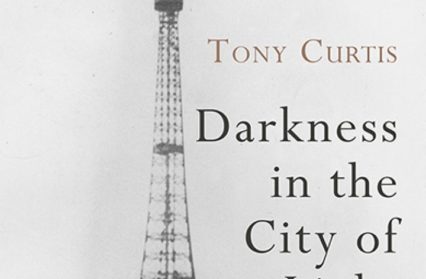Nathan Munday reviews Darkness in the City of Light by Tony Curtis, a multi-form, genre-bending novel set during an era of fear and tyranny in Nazi-occupied Paris.
Asking relatives about their wartime memories was something I enjoyed doing during those long Sunday afternoons. Images appear, even now, like postcards from places I’ve never visited – the orange strip of Swansea’s skyline, the drumming Luftwaffe, iron crosses disturbing the early snow, and the edginess of a bruised Berlin – each pinned somewhere deep inside me. I guess that these sanitised scenes formed a ‘Great Escape’ for the younger self, but the reality is, I had no idea about the despair that each one entailed. We all do it to some degree: capturing specimens from those perplexing times, bottling them up, and studying them through the cloudy glass of hindsight.
We do this before the eyewitnesses die, lest we forget.
I recently tried to raise that ominous period with my wife’s Dutch relatives, but it was getting awkward. “It was a hushed-up time”, whispered Jenna, hoping that I wouldn’t press them any further. I should have known better. The Dutch suffered terribly during the Nazi occupation.
For better or for worse, what happens in war, stays in war. Does it? No. Tony Curtis’s thrilling new novel, Darkness in the City of Light, doesn’t shy away from the idea of ‘evil’ and ‘darkness’ seeping out of that period of flexible morality. Its Tableaux Parisiens is a genre-defying survey of a fissiparous city whose inhabitants ‘move in the shadows’. This is a city where the Gestapo are always ‘a few streets away’, where nothing is ‘my business’, and where ‘cries of help in the distance’ are repeatedly ignored. Many of these shadows never see light again especially after entering a certain ‘house in the Sixteenth’. Everyone seems to take these stories ‘with a pinch of salt’. After all, ‘what can you believe these days?’ is a recurring mantra running through the novel.
At first the story is confusing, the different fonts are cryptic, and the murder case is difficult to follow. Stretching backwards and forwards through the twentieth century, we don’t always understand why a particular person is speaking or whether a piece of prose is real or counterfactual. Things do eventually fall into place just like one of those gripping Netflix documentaries binge-watched into the early hours.
The French flaps provide us with a dissected face, an embodiment even, for the evil that emerged onto the boulevards of Europe. His name was Marcel Petiot. This Jekyll and Hyde looks straight at us. Is he a doctor, collaborator, Maquisard, psychopath, and/or serial murderer?
Nobody really knows.
History suggests a liar extraordinaire. Posing as a quasi-messiah for the outcasts, these so-called ‘enemies of France’ – Jews, prostitutes, resistance fighters, and criminals – were wooed unto him with the carrot of freedom. This offering of false hope was perhaps what repulsed me the most as I read.
There was talk of an underground escape route, a house in the Sixteenth, but who knows what is real, actual and what is just rumour and despair?
This ‘bereted’ angel of light suddenly metamorphosed, poisoning his desperate victims before keeping their valuables for himself. A macabre list trickles down the first page eerily reminiscent of the records of Auschwitz or Treblinka – the 60 and the 6 million savagely murdered. When caught, Petiot’s defence was that he was working for the Resistance and that these were all traitors and collaborators.
Curtis cleverly curates this documentary on paper. Weaving poetry with prose, he reveals the limits of language, showing us how different fonts changes the way we look at a story or the way in which we view its speakers. There are Holocaust allusions throughout making its Parisian setting microcosmic. David Llewellyn, in his review for Nation.Cymru, mentions how Curtis gives a voice to the disappeared, ‘often feel[ing] like a final act of restorative justice’:
Fool! Didn’t you know
the dead stick to you.
You may wash us off your hands,
but we are inside you.
Monsters haunt the pages alongside those famous figures like Picasso and Hemingway. The obvious ghouls parade the front and back covers: sightseers in their leather boots and swastika sleeves, and the mug shot of Dr Satan split in half. However, this book suggests a darkness running far deeper than the Nazi germ or the unusual maniac. In the spirit of Baudelaire, who in 1856 complained that the great heresy of his time was ‘the suppression of the concept of original sin’, a damning question flickers throughout: how could they let this happen?
It’s easy for us to judge the Picassos, but I wonder how we’d react if the Gestapo came knocking on our doors, or if we heard those nocturnal pleas for help? The novel taps into that idea of neighbourhood, turning the Woolfian mirror back on us. Between these monstrous acts, we all have a duty and a responsibility. Keeping the monsters away – both in wider society and closer to home – has never been more pertinent.
Darkness in the City of Light is an important book which gives a voice to the voiceless, yes, but it also shows how quickly things can go awry. Seren deserves praise for its book design and for recognising the importance of these experimental, multi-form novels which challenge conventional boundaries. I hope that many more poets will follow Curtis’s example.
Darkness in the City of Light by Tony Curtis is available via Seren Books.











